Dynamic Stability of Liquefied Cargo Ship in Waves
2019-01-09
(College of Shipbuilding Engineering,Harbin Engineering University,Harbin 150001,China)
Abstract:Recent problems with liquefied cargoes leading to serious loss of life are attracting attention by the international community to address this problem scientifically.Even though there is much yet to be understood concerning the phenomenon itself,for example its inception and cargo behaviour post-liquefaction,it is more than likely that liquefied cargo will behave as a non-Newtonian fluid.With this in mind,a numerical simulation method is presented in this paper based on CFD technique to consider tank sloshing and dam break of water and liquefied cargoes.Calculated results are compared with experimental data to verify the method.Herschel-Bulkley fluid is chosen as the non-Newtonian fluid to describe the properties of liquefied cargoes.To assess the dynamic characteristics of liquefied cargoes,coupled motion of the 2D cargo ship filled by liquefied cargoes in waves was studied based on the proposed method.
Key words:cargo liquefaction;ship stability;CFD;non-Newtonian fluids
0 Introduction
Over the past few years,the risk of cargo liquefaction on the safety of ships has risen sharply.Such a transition during ocean carriage can cause a sudden loss of stability of the carrying vessel[1].Liquefaction of mineral ores,such as ore fines from India and nickel ore from Indonesia,the Philippines and New Caledonia,resulting in cargo shift and loss of ship stability,has been a major cause of marine casualties over the past few years.While cargoes are loaded on board a vessel,the material is exposed to mechanical agitation and energy input in the form of engine vibrations,vessel motions and wave impact,resulting in a gradual settling and compaction of the cargo.The gaps between the particles become smaller in the process with the corresponding pore pressure progressively increasing.As a result,the water holding ability or matric suction of particles decreases and the friction coefficient of cargoes decreases.Especially,the water in the interstellar spaces comes together to form a liquid layer that allows the cargo above to move relative to the cargo below as if the two layers were part of a liquid,hence the tern liquefaction.When mineral ores have liquefied,this liquid shows the properties of non-Newtonian fluid,demonstrating characteristics of shearing thinning and yield pressure.In the last ten years,more than ten ships capsized and sank due to a loss of hull stability attributed to the cargo liquefaction[2-3].Especially,‘STELLAR DAISY’ from South Korea capsized due to cargo liquefaction in March,2017.The above tragic accident is not the only one of its kind and unfortunately,it will not be the last unless immediate and comprehensive action is taken by the industry.
The inception of roll instability for a vessel containing a rectangular hold partially filled with dry granular material is investigated by applying a simulation approach based on coupled micro-scale modelling of particles with vessel motion[4].An experimental investigation and numerical simulation had been presented to study the water sloshing in a rectangular tank[5].It is indicated that CFD techniques may be used to predict the behaviour of the free surface of the fluid during the container initial motion and after.KIM[6]adopted a time-domain approach to solve the coupled problem of ship motion.Ghadampour et al[7]employed incompressible SPH to simulate free-surface mudflow for two case studies,including dam break and flow under a gate.Mass and momentum conservation equations in a 2-D Lagrangian frame,along with the Herschel-Bulkley rheology model and VOF model,were used in this simulation.Experimental methods have been used to predict mudflow behaviour[8].Experimental investigation of the spreading of viscoplastic fluids on inclined planes has been done to reconstruct the free-surface evolution of fixed volumes of fluid suddenly released a plane using image processing techniques.Dam break flows of viscoplastic fluids are studied theoretically by using a Herschel-Bulkley constitutive law and a lubrication model of the motion[9].In principle,the viscosity of fluid should be measured using an experimental method and the viscosity model need to be revised according to different fluids.A new Herschel-Bulkley model was developed for mud flow down a slope to describe the yield-stress and shear-thinning behaviour[10].Thus it can be seen that an accurate viscosity model is crucial to simulate the behaviour of a non-Newtonian fluid or liquefied cargoes.
1 Numerical formulation
Reynolds averaged Navier-Stokes equations(RANSE)with SST k-ω model were solved.The VOF algorithm was applied to capture free surface.The governing equations can be written as follows:
Continuity equation:

where▽is the hamiltonian or gradient operator,u is the velocity vector.
RANSE equation:

where g is the gravity vector,P is the pressure,μ is the viscosity.
SST k-ω turbulence model:

where Gkis the production of turbulence kinetic energy,Gωis the generation of ω,Γkis the effective diffusivity of k,Γωis the effective diffusivity of ω,Ykis the dissipation of k due to turbulence,Yωis the dissipation of ω due to turbulence,Dωis the cross-diffusion term,Skand Sωare the user-defined source terms.
VOF equation:

The roll equation is written as:

where I4is the moment of inertia,k1is the external computed hydrodynamic roll moment,k2is the internal computed hydrodynamic roll moment and mg×GM×sin()α is the righting moment.
2 Test cases and results
2.1 Dam break and tank sloshing of water
A dam break flow experiment was performed in a tank measuring 3.22 m×1 m×1.8 m[11],as shown in Fig.1.After the flap was removed,the water with an initial water height equals to 0.6 m flowed freely.The water elevations and pressure were measured by using two water height probes(H1 and H2)and one pressure gauge(P1).The problem can be considered as a twodimensional flow problem in the simulation.The computed results are compared with the experimental results.It is apparent that the present results agree reasonably well with the experiment results as shown in Fig.2 and Fig.3.When,because of the limit in accuracy of measurements in the chaotic flow and the difference between flap lifting process,the calculation data show a large deviation from the experimental data.
An experiment was performed to solve the tank sloshing problem and compared with the experiments of liquid sloshing in a horizontally excited tank which has been performed by Liu and Lin[12].The tank is 0.57 m long,0.31 m wide and 0.3 m high.The static water depth is 0.15 m.The lowest natural frequency(ω0)of liquid motion in the tank is 6.057 8 s-1.The tank is fixed on an oscillating table in sinusoidal motion:x=-a*sin(t).The motion amplitude(a)is 0.005 m and the sloshing frequencies(ω )is 1.0ω0,resonant cases.The water elevations were

Fig.1 Sketch of the 2-D dam break experiment(left)and sloshing experiment(right)(units:mm)
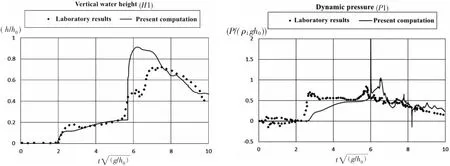
Fig.2 Comparison of the time history for vertical water height at H1(left)and dynamic pressure at P1(right)
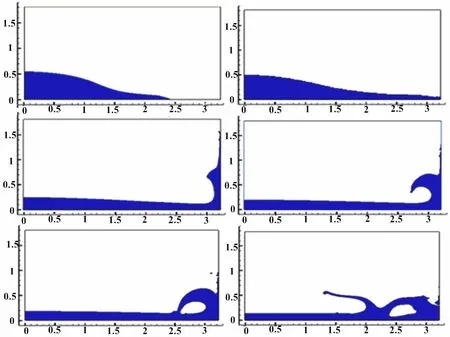
Fig.3 Contours of 2-D dam break=1.66,2.43,4.81,5.72,6.17,7.37)measured by using three water height probes(H1,H2 and H3).The sketch of the sloshing experiment is shown in Fig.1(right).
Dynamic mesh method is used to simulate the tank movement.The no-slip wall condition is imposed on the entire boundary.Contrasting data have been omitted.The numerical method can be validated with the experimental data.The free surface elevation at H1,H2 and H3 is calculated and compared with experimental results.It could be seen that the present results have a good agreement with the experimental results,as shown in Fig.4.
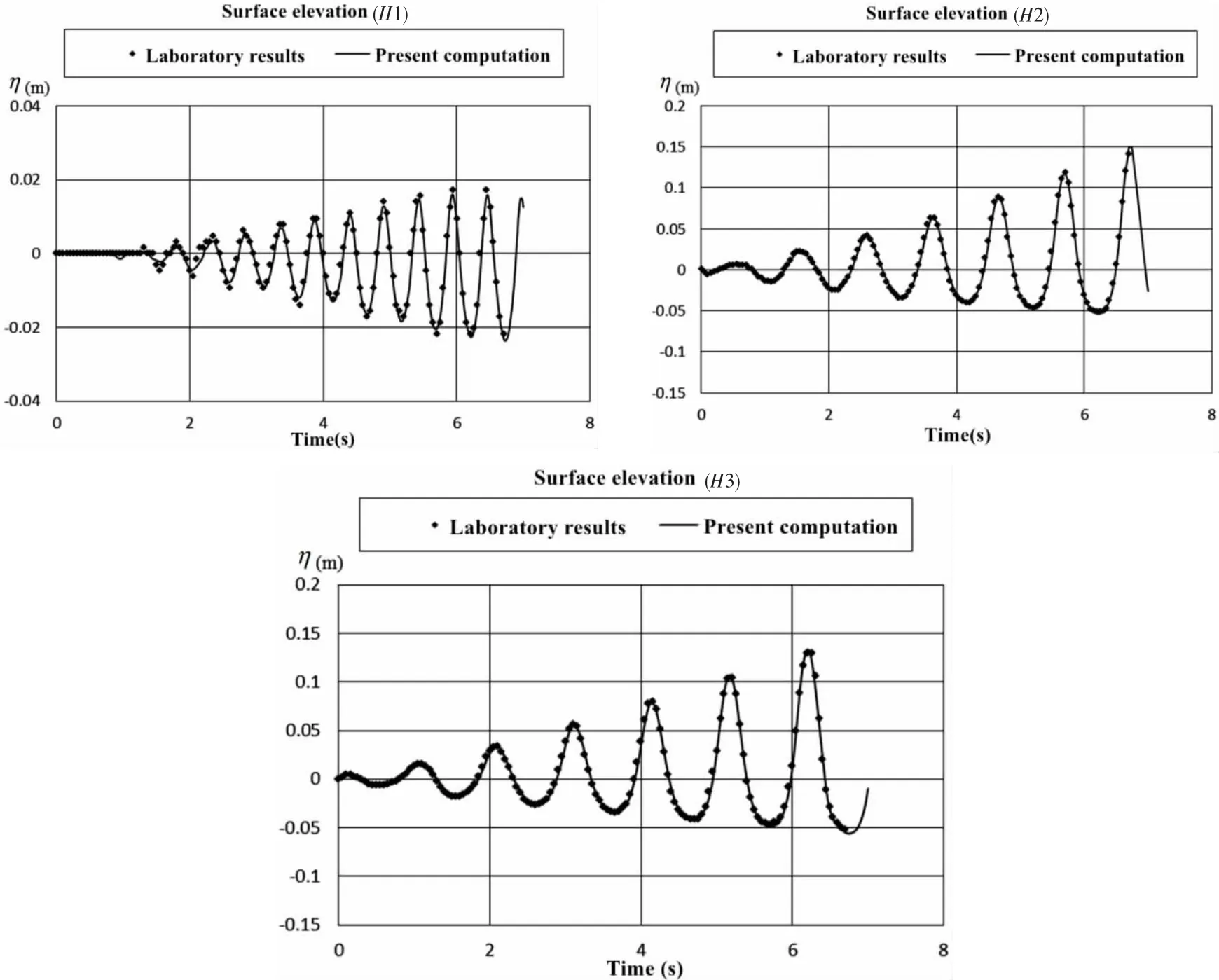
Fig.4 Comparison of the time history for free surface elevation at H1,H2 and H3(ω=1.0ω0)
2.2 Dam break and tank sloshing of non-Newtonian fluid
The dam-break flow involving non-Newtonian fluids is tested here.According to the experiments of non-Newtonian dam-break flows[13]is used as experimental,which could be modelled by the Herschel-Bulkley constitutive equation.


where n is the flow index,k is the consistency index,τcis the yield stress,˙is the strain rate tensor,andis the second invariant of˙.

Tab.1 Property of Carbopol 940
Properties of this fluid used on the dam-break experiment are shown in Tab.1.
A sketch of the dam break experiment is shown in Fig.5.h0is 100 mm.The numerical data were compared with the experimental data and some published data in literature.The present method showed better agreement with the experimental results,as indicated in Fig.6.

Fig.5 Sketch of dam break experiment(units:mm)
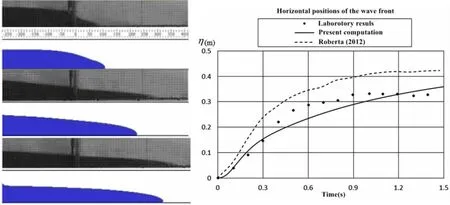
Fig.6 Contours of 2-D dam break of liquefied cargoes at T=0.2 s,0.6 s,and 1.0 s(left)and horizontal positions of the wave front(right)
The influence of the variables in the Herschel-Bulkley constitutive equation on the character of Carbopol 940 was studied including the dam break and tank sloshing,as shown in Fig.7 and Fig.8.The sketch of dam break and sloshing experiment is the same as Fig.1.However for the sloshing moment,when T>0 s and T<1 s,the tank has a horizontal velocity 0.4 m/s.when t>=1 s,the tank stops.
It is known that if n<1,the fluid is shear-thinning,while n>1 produces a shear-thickening fluid.Shearing thinning means viscosity decreases when the velocity gradient increases.Yield pressure means when only the shear stress is greater than yield pressure(τc)the local fluid moves and the greater yield pressure,the more inert the fluid.If n=1 and τc=0,this model reduces to a Newtonian fluid.Fig.7 shows that liquefied cargoes which have low index n and yield pressure have large flow characteristic.For the instantaneous exciting experiment shown in Fig.8,when T<1 s,water sloshing is severe and it has not the restriction of yield pressure.When T>1 s,the non-Newtonian fluid will stay one side for a long time.During the carriage,the cargo will experience a transition from solid to partially liquefied state,and then to fully liquefied state.All of these three states have an impact on ship stability.When the cargoes liquefied enough,this will greatly change the flow properties of the cargoes and tend to flow.The liquefied cargoes flow to one side of the ship and do not completely return,which influences the gravity centre of ship and further reduces the ship stability.

Fig.7 Horizontal positions of the wave front versus flow index n(left)and yield pressure τc(right)for dam break
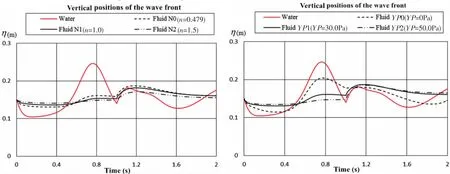
Fig.8 Vertical positions of the wave front versus flow index n(left)and yield pressure τc(right)for tank sloshing(right wall)
3 Coupled motion in waves
Roll motion in waves of a rectangular structure was investigated in a wave tank at Texas A&M University[14].The rectangular structure with the dimensions of 0.3 m long,and 0.3 m high was used as a scaled down barge in the simulations.The structure floated at a draft that equals one-half of its height.The moment of inertia of the actual mass of the structure is 0.236 kg·m2.
First,the roll decay was conducted in the calm water condition.We can see the profile of computation domain and mesh distribution in the two dimensional numerical tank in Fig.9.Mesh interface technique was used in the roll motion for the data transfer.For the roll decay test,the structure was initially inclined with an angle of 15 degrees and then released.The roll motion decayed after each cycle due to the damping effect as shown in Fig.10(left).Comparisons to the experimental data,the results show great agreements.
The dynamic response of the rectangular structure under linear wave was tested in the numerical tank.The wave parameters are shown in Tab.2.The gravity centre was set at the lo-cation of(7 m,0 m).The coupled interaction between the linear wave and the structure was demonstrated by examining roll angle at the natural frequency.As shown in Fig.10(right),the results in the numerical simulation are consistent with the experimental data with a maximum roll angle of 10 degrees.

Fig.9 Mesh distribution and profile of free water surface in linear wave

Tab.2 Parameters of linear wave for roll motion

Fig.10 Time history of roll angle in roll decay test(left)and in linear wave(right)
A compartment(0.2 m*0.13 m)was installed in the rectangular structure to simulate the motion of ship considering sloshing(see Fig.11).It is filled with water and liquefied cargoes(0.2m*0.045m)with flow index 0.479,yield pressure 30 kPa and different density,1 000 kg/m3,1 250kg/m3and 1 500 kg/m3separately.Other conditions remain unchanged.

Fig.11 Sketch of calculation domain considering sloshing for coupled motion
Fig.12 shows the contours of coupled motion in waves with water and liquefied cargoes at time=10.8 s,11.0 s,11.2 s and 11.4 s.Ship motion excites flu-id sloshing,and sloshing-induced internal loads affect the ship motion in return.It can be seen that due to the properties of non-Newtonian fluid,the cargoes show great inertia.Cargo density greatly affects the ship stability.If the cargoes shift to one side,the gravity centre will shift due to the large density of cargoes.In some cases,the moment induced by the cargo movement is significant and causes a sudden loss of ship stability which can make a large contribution to ship capsize.From Fig.13,the maximum roll angle becomes small with a large cargo density.This means the liquefied cargoes restrain the roll motion greatly and in regular waves,the cargoes will keep stable and reduce the roll motion.Roll motion in regular waves will influence the onset of liquefaction,but still will not cause the cargo shift.For the reason of cargo shift to reduce the ship stability,it can be seen from the properties of non-Newtonian fluid that if the shear stress is lower than the yield pressure,the fluid cannot flow.Therefore,it can be concluded that instantaneous exciting force like the severe ship roll in freak waves causes the flow to shift to one side.
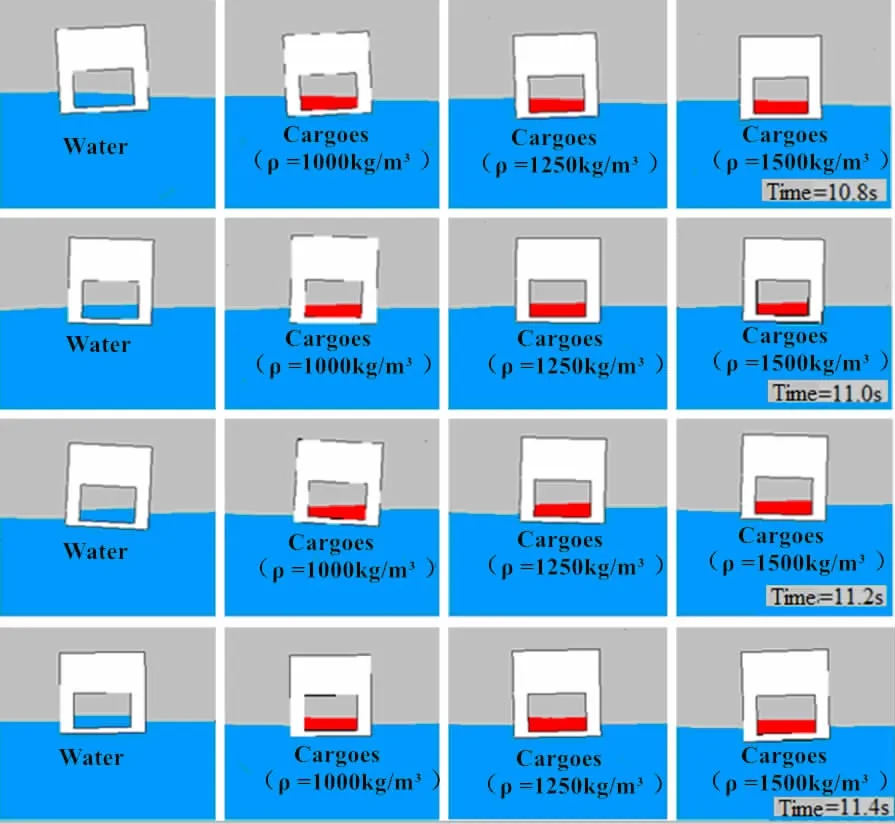
Fig.12 Contours of 2-D coupled motion in waves filled with water and liquefied cargoes at different cargo density(Time=10.8 s,11.0 s,11.2 s and 11.4 s)
Based on the analysed results above,an instantaneous exciting angular velocity(1.5 rad/s)was imposed on the compartment to study the flow characteristics in different cases.It can be seen in Fig.14 that when the compartment is empty,due to the damping effect,the roll angle gradually decreases;when the compartment is filled with water,the roll motion is affected by the water sloshing slightly;and especially when the compartment is filled by liquefied cargoes,the shear stress caused by the instantaneous exciting force resists the yield pressure and the liquefied cargoes begin to move to one side.Then the cargoes will do not flow to the other side and remain stable until the shear stress is less than the yield pressure.After that,the gravity of the ship will be changed greatly due to the high density of the cargoes.The ship progressively reaches a dangerous heel.With experiencing severe waves,ship motion excites liquefied cargoes sloshing,and sloshing-induced internal loads from the liquefied cargoes affect the ship motion.When the righting moment of the ship could not resist the moment caused by the shift of cargoes and the external hydrodynamic moment,the ship will capsize unpredictably,rapidly,and deadly.
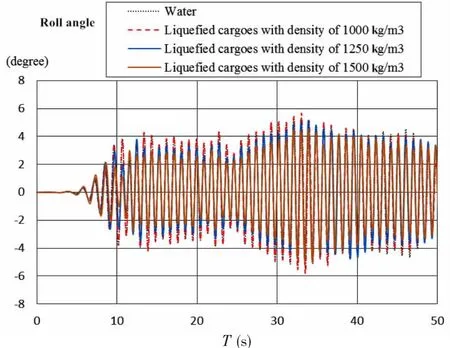
Fig.13 Time history of roll angle for coupled motion in waves filled with water and liquefied cargoes at different cargo density
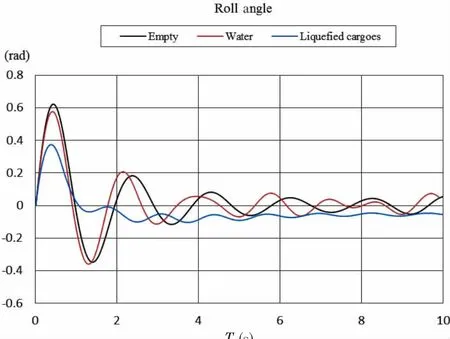
Fig.14 Time history of roll angle for coupled motion in instantaneous exciting force filled with no water,water and liquefied cargoes
4 Conclusions
Based on a series of computations including dam break,tank sloshing,free roll decay and coupled motion in waves for 2D rectangular structure,comparison with existing experimental data,the following conclusions can be drawn:
Tests for dam break and tank sloshing agree well with experimental data.Dynamic mesh method and Herschel-Bulkley model combined with VOF method could be used to simulate ship motions and liquefied cargo characteristics.Different fluids require different constitutive equations,which needs to be obtained by an experimental method.
From the coupling analysis of ship motions and sloshing flows,ship motion excites fluid sloshing,and sloshing-induced internal loads affect the ship motion in return.Roll motion of rectangular structure in regular waves will influence the onset of liquefaction due to the compaction gradually but is hard to cause the cargo shift.From the properties of non-Newtonian fluid that if the shear stress is lower than the yield pressure,the fluid cannot flow.Therefore,instantaneous exciting force like the severe ship roll in freak waves is the reason causing the liquefied cargoes to shift.When the righting moment of the ship could not resist the moment caused by the shift of cargoes and the external hydrodynamic moment,the ship will capsize.
This method in the paper could be feasibly used as a reference and possibly support a suitable regulatory framework to the liquefaction analysis of ship stability.
杂志排行
船舶力学的其它文章
- Investigation on Time Domain Motions for Ship and Floating Structure and Coupled with Nonlinear Sloshing
- Overset Simulations of Submarine’s Emergency Surfacing Maneuvering in Calm Water and Regular Waves
- A Revised Method for Predicting Added Waves Resistance Based on Comparison of Theoretical and Empirical Results for VLCC Hull Forms
- 3D Nonlinear Hydroelastic Response and Load Prediction of A Large Bulk Carrier in Time Domain
- Strength Characteristics of Maraging Steel Spherical Pressure Hulls for Deep Manned Submersibles
- Research on Stress Intensity Factors for the Deflected Crack of CTS Specimen
